小学英语说课稿全英三年级整理版.ppt
- 格式:ppt
- 大小:102.00 KB
- 文档页数:20
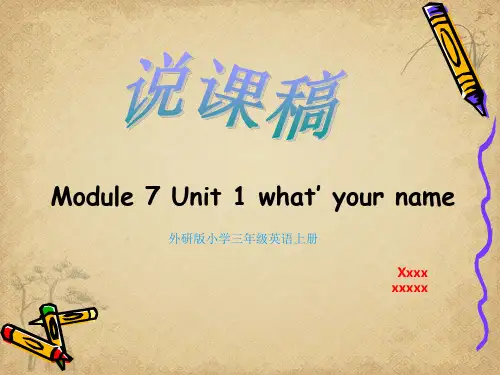
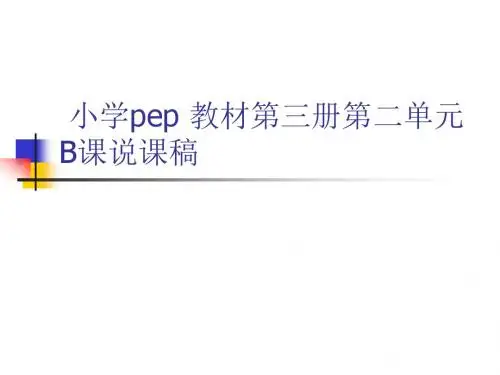
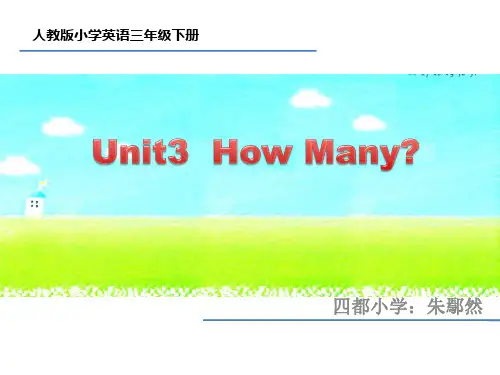

小学英语说课稿①Good afternoon , Ladies and Gentlemen !My name is Wu Dan . I come from Tanggangzi School .I am very glad to be standing here and talkingabout Lesson 10 ,which is from Fun with English Book 3 Unit 2 .My teaching report includes four parts .Part 1 To analyze the book1.There are 3 units in Book 3 . This is Lesson 10 . The central item is how to master another sentence to express“What ’s the time ? ”and how to buy something. Using “What ’, c s a k t h e e s,t i b m r e a?d and s”o o h n u.n W gr e y’study and drill the sentences and the word ’s pronunciation .2. According to the teaching outline and combining the students ’situation , I make the teaching aims of thfollows .a .The first is the aim of knowledge .It ’s to learn and m a s t e t w r o sentences. What time is it? I am hungry and then using them to express the time and goshopping fluently and freelyb. The second is the aim of abilitiesThe creative spirit is quite important to the students. So I will pay much attention to train it in my class. Otherwise. Iwill try to train the students listening, speaking, reading and writing abilities, Mainly improve their communicativeabilities and encourage them to speak more English.C. The third is the aim of emotionMake the students have successful feeling and achievement. And make them be in English study.3.Important pointsThe first is to master and use the two sentences. What time is it? I ’m hungry. The second is to masterwords hungry, cakes and bread.4.Difficult points.It ’s the pronunciation of the two words. hungry, cakes, and how to use them fluently and freely .Part 2 . Teaching and learning methodsMake the students take part in class . Ask and answer in pairs and groups . I ’l u l se communicative method , discussing method and seeing and hearing method to teach this lesson .Part 3 . Teaching aids .In order to interest the students . I ’ll use a clock , recorder , cards and some food as my teaching aids .Part 4 . Teaching procedure .Step 1 RevisionBefore my c lass , I ’ll get the students to sing an English song to keep themselves relax . Then IWhat’s the time ? What ’s the time ? It ’s eight o ’clock . I ’ll show three numbers . When the students o’clock . I ’: I l tl s a t’y e n s. Today we ’ll learn Lesson Ten . Then I'll put the clock on the blackboard .Step 2 Presentation and drillFirst I ’ll point to the clock and ask , what time is it ? Students answer It ’s ten . Then I go on moask .What time is it ?Students answer quickly .Second I ’ll drill the sentences What time is it ? It----- .pairs in pairs or’r o w s by row .Third When the students answer It ’s 12:00 o ’clock . I ’ll point to my stomach and say .O hI ’I ll eat a ’mcake . Then I ’ll g s o a o y i n n g I ’m hungry .and I ’ll eat another cake . I ’ll act it four or five times . Then I ask to act it . I ’m hungry , too . I ’ll say two cakes , please .and the sentences .I ’m hungry . TwoForth :Listen to the dialogue and answer my questions.1.What time is it?2.How many cakes?Step 3 ConsolidationI ’ll train the creative spirit of the students.I ’ll give them three please. To act the dialogue freely .First at the 219 Park,second fruit shop Third department store.Step4.HomeworkEncourage my student to the market to buy something with his friends or parents.②Good morning, everyone!Today, I ’ll say something about Unit 9 Part A in Book 4 of Oxford English.Background on the reformation of curriculum, this book can connect the life and act, emphasize the interest and experience of the Ss, the pictures are active and vivid. Grade four is the initial stage of English learning, so it stresseson the emotion of the Ss, creates a well beginning for the Ss. This Unit has 7 parts, we’lllearn Part A mainly, it embodies the repeating characterize. Review the learned language points “Where’s⋯” and the newwill be represented in the following units. So this unit forms connecting links with a special meaning in this book.The content of this period is to use ar“e⋯W”h ereto’d s e termine the place. And according to the contents and thefact of the Ss, I establish the following three teaching aims of this period:The first one: students can listen, read, say and spell the following words: a glass, a fridge, an egg, bread and a table.The second one: students can listen, read, say and write the following daily expressions: What ’Have some juice then.The third one: students can listen, read, say and write the fol lowing sentence patterns: Where ’s my⋯It ’T shey ’re ⋯There ’s no ⋯in near ⋯I think the most difficult point of this period is to make sure the students can use the patterns “Where’\Ws hereare ⋯and There is no ⋯n i e n a r⋯”in their dayillife correctly.And I will use some pictures, words and sentence cards, a tape recorder and the multi-media computer to help meachieve the aims.The task-based method, communicated method, group cooperate method will be used in this period.To accomplish the aims, I design the following steps:Step 1 Songs and the game arousers the emotion.In order to attract the Ss’a ttention and construct an atmosphere of learning English, I let the students sing someEnglish songs and play the game “S i m A o t n t h s e a y s s a m”e t.i me the game can review the prep, serve the knowledgeas foil and consist the appearance of the knowledge.Step 2 Change class to life, happy to say.The substance of language is communication and the environment of communication is life. So when I present thesentence pattern “What’s for breakfast? ” I first show a clock to elicit the time for breakfast, teach the sentence. Th show my own photo of having breakfast, Ss ask and guess. In this way I can attract Ss ’a skattention, eQs with the new knowledge.Most of the Ss have learnt the sentence pattern: Where ’s⋯? so I design a task for Ss to help Helen find the fo drinks for breakfast, and teach the new language points: Where are ⋯? They ’re ⋯M e a n s w o h n i l e stick thethe Bb.After some practice by asking and answering, I present the next language points:There ’s no ⋯innear ⋯Have ⋯then.And I will stick these sentence patterns on the Bb. Finally I ’ll let the Ss do pair works to consolidate them Step 3 Listen to the tape and Ss imitate to read and say.As the new reformation of curriculum, emphasized the traditional class attach importance to the mechanical teaching,neglect the experience and participation, for example, the five-step method. So in this lesson, after presentation, I askSs to listen to the tape with three Qs, read in different roles and in pairs, then try to recite the text.Step 4 Ss be the main body, T makes a guider.In class, Ss play as a host, and the T makes an influence on guiding, help Ss to act the learnt dialogue, it can stress the position of the Ss, and arouse their interest.Then I show a carton with no voice, ask Ss to make a dialogue in pairs.There are lots of ways to consolidate the new knowledge. Playing game is a good way. So according to the physiology of Ss, I hold a group competition during the game, ask Ss to finish the blanks. In this way can develop Ssgood habits and achieve the aim of mastering the learned knowledge in situation.Step 5 Change class to life, learn by themselves.Is this the end of the class? I don ’t think so. If there is an end, I think it should be in the life. So I extend this class, encourage Ss to use the learned to communicate with each other in their life.In a word, the whole period is based on tasks, which are designed from easy steps to steps that are challenging. Whenthe Ss are carting out the tasks, they can acquire information, knowledge, and have their ability and skills trained.That ’s all. Thanks a lot for your attention.稿课全英说Good morning everyone. Standing here, I ’m very happy and excited. It ’s m be here to present my lesson, and the chance is very precious for me. And IToday I ’ll talk about unitfrom my contents consist of 8 partsAnalysis of the teaching materialAnalysis of the studentsTeaching methodsTeaching aims and demandsTeaching aidsTeaching procedureBlackboard designAnd conclusionWell, firstly, I ’ll talk about part 1 analysis of the teachin.g I m h a a v t e r c ia o l ncluded the features of ⋯⋯ .1 . there are a lot pictures. For this, the kids will be interested in the book. As we all knowthat interest is best teacher for the students.2. It lays stress on the communication. According to the problem of Chinese students learning English , the book design a lot of material to improve the studentslistening speaking, reading, and writing. So I think the book is very good.Then I ’ll talk about next part analysis of the stud.e I n t t i s known to us that the kids arevery active and like playing games very much, so during my class, I ’ll desig interesting games to activate them to participate and learn something. They will also be interested in the class.Next I ’ll talk about teaching metho M d y s.teaching methods are task-based approach and situational approach. Using different methods can make the class active.Let ’s move on to another part, teaching aims and demands. There are knowledge aimsand ability aims.Knowledge aims are to enable the studentsot master the words and phrases: ⋯⋯⋯. And the sentences: ⋯Ability aims are To improve students ’listening and speaking ability by reading and practicing the dialogue.Next is the teaching aids.In this class, I ’ll use pictures, PPT and tape r e c o r e d e c r a.n Thes arouse the students ’ interest in English.Now I ’ll talk about most important part teaching procedure. It consists of 5 steps. Warningup, lead-in, contents key points and difficult points and homework.Step1 is warming up. Here I ’ll use PPT to pal aE yngl i s h song Bingo for the students andI ’ll ask them try to follow it to sing together. By this, the students can be interested in it andpay their attention to our class easily and improve their ability of speaking.Step2 is lead-in (导入根据所授内容设计,可通过展示与本课有关的话题或者图片等等引出本课话题)Step 3 is contents(本部分为主要授课内容及组织的课堂活动。
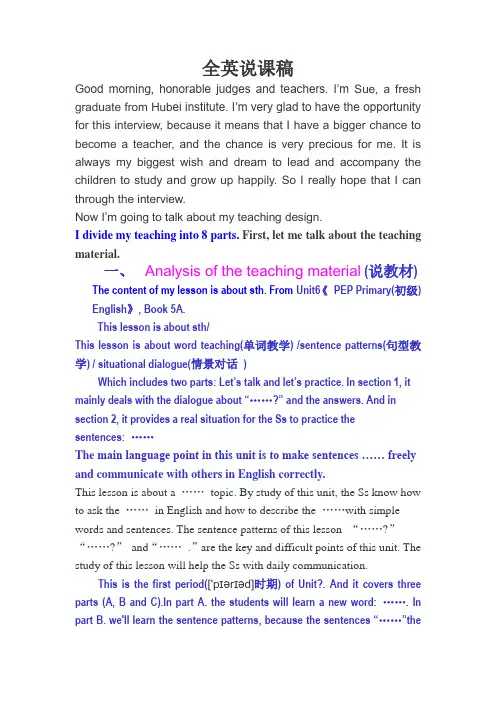
全英说课稿Good morning, honorable judges and teachers. I’m Sue, a fresh graduate from Hub ei institute. I’m very glad to have the opportunity for this interview, because it means that I have a bigger chance to become a teacher,and the chance is very precious for me. It is always my biggest wish and dream to lead and accompany the children to study and grow up happily. So I really hope that I can through the interview.Now I’m going to talk about my teaching design.I divide my teaching into 8 parts.First, let me talk about the teaching material.一、Analysis of the teaching material (说教材)The content of my lesson is about sth. From Unit6《PEP Primary(初级) English》, Book 5A.This lesson is about sth/This lesson is about word teaching(单词教学) /sentence patterns(句型教学) / situational dialogue(情景对话)Which includes two parts: Let’s talk and let’s practice. In section 1, it mainly deals with the dialogue about “……?” and the answers. And in section 2, it provides a real situation for the Ss to practice the sentences: ……The main language point in this unit is to make sentences …… freely and communicate with others in English correctly.This lesson is about a ……topic. By study of this unit, the Ss know how to ask the ……in English and how to describe the ……with simple words and sentences. The sentence patterns of this lesson “……?”“……?”and“…….”are the key and difficult points of this unit. The study of this lesson will help the Ss with daily communication.This is the first period(['pɪərɪəd]时期) of Unit?. And it covers three parts (A, B and C).In part A. the students will learn a new word: ……. In part B. we'll learn the sentence patterns, because the sentences “……”thestudents have learned before, so the new sentence pattern for them is 'What for?’. Part C is the most important part in this lesson. It is just to teach the students …. And …will be taught next lesson.This is a dialogue that happens in somewhere .several sentences surround sth will be learned.This dialogue(或lesson) is close to the actual life of the students, which would attract the students’ curiosity [kjʊərɪ'ɒsɪtɪ] (好奇),interest and attention. And we pay attention to training the students’ ability of the listening, reading and writing.二、Teaching aims (教学目标)Next part is teaching aimsAs we all know: the main instructional(教学) aim of learning English in primary school is to cultivate pupils’ basic abilities of listening and speaking and their good sense of the English language, So I put forward the teaching objectives of this lesson as follows.1. Aims on the knowledge1) Aims on the knowledge is to enable the students to learn some new words, such as …… and so on, and to master the sentence patterns: “……"2) The Ss can understand and read the conversation(对话)of the lesson.2. Aims on the abilities(1)The ability aim is to enable the Ss to understand and speak: “…….” Make sure that Ss can use these sentences in real situations.(2) To develop Ss’ abilities of communication and their innovation(创新).3. Aims on the emotion(1) The emotion aim is to f oster Ss’ consciousness(['kɒnʃəsnɪ(/ə)s]意识)of good co-operation and proper competition.2) By completing the task, the Ss increase their interest and set upself-confidence in language study;IV. Next, the key-points of this lesson(说重点)(1) The students study and use the sentence patterns “……”,and improve their abilities of listening,speaking ,reading and writing; (2) Teach the Ss how to study independently(独立的)as well as by cooperation(合作).(3) Develop Ss’ interest in English.V. Difficult points(难点)(1) The students can understand the meaning of the new sentence patterns and use them correctly.(2) The Ss can use the words and patterns to describe the sth in the proper scene.((3) The students can finish the survey by themselves.)三、Analysis of the students(学情分析)Then I’ll talk about the analysis of the students.The students I’ll teach are the (fifth)-grade students. They are very active and they like singing, dancing and playing games.The students in Grade 5 have had some basic English knowledge and they can express themselves in simple English. They are eager(['iːgə]渴望) to learn more and have been interested in EnglishIn the past few years of study,the students have learned some words,phrases and some simple sentences.They have great interest in learning English now.四、Teaching aids(教学准备)Next part is teaching aids. In this lesson, I’ll use the pictures, word cards, Multimedia(['mʌltɪmiːdɪə]多媒体),and tape recorder. Thesecan stimulate students’ interest in English.五、Teaching methods(教学方法)Then I’ll talk about teaching methods.Well, how to achieve the teaching objectives better, how to stress(强调) the key points and overcome the difficult points? The answer is proper teaching methods,I’ll mainly use the TBLT method and situational approach in this lesson.It is known to us that the kids are very active and like playing games very much, so during my class, I’ll design some interesting games to stimulate the interest of the ss. And the students will use the active learning and cooperative learning六、Teaching procedure(教学过程)The Teaching procedures and purposes of my designingNow I’ll mainly talk about the most important part of the teaching design: teaching procedure.I’ll finish this lesson in f our steps.Step1. Warm-up(热身)I will begin this lesson with a song.Sing a song will make students feel pleased and satisfied and also it can a rouse their exciting emotion.Then I'll have a free talking with the students, because free talking is an important way to improve the students' ability of speaking. I’ll ask the students some questions like: What day is it today? What's the date today? What's your favourite subject? What do you like doing?this step is used to review the knowledge in the formerunits and make an atmosphere(['ætməsfɪə]气氛) of English learning.Step2. Presentation and practice(呈现新知)Firstly, present the new words:……and so on with the help of CAI.Ask students to watch and repeat the words.Secondly,show the pictures by PPT, ask the students practice the phrases:…… By acting and saying, the using of PPT makes the presentation of the words active, direct and vivid. It will help the students get a better understanding of the phrases.Thirdly, Watch a video (观看多媒体,了解本课故事情节),Present the situation to help the Ss know what's happening in the story . (This part is important and effective)It will provide a real situation for the students to understand themeaning of the new words better, and also it will arouse the students’ interest of English learning .Step3. Consolidation (巩固)First, I will ask them to make a dialogue with their partners,they can talk to several classmates who they want to co-operate with,so they can walk freely and speak loudly, in this way, theywill feel happy and successful. By communication,the students will understandthe sentence structure better and master the knowledge firmly.Then I’ll divide the whole class into several groups to have a competition, in each group, I’ll ask one student to make the corresponding reaction, and the others guess what the word expressed by the student is. Then lead the Ss to read the sentences. Make sure they can say it correctly.Purpose:competition is a good way to stimulate students’ interest. Andit will develop the students’ ability of communication and co-operation.Step4. Summarize(或conclusion)and assignment ([ə'saɪnm(ə)nt]任务,作业) (课堂总结,布置任务)Make a summary after each lesson is very necessary, it can help students to absorb and storage the knowledge of this lessonAt last,I’ll arrange the homework.1.Write the words 10 times in their exercise books.2.Say something about …….Let the students speak English in theirdaily lives.I think homework is so important that the Ss should use English as much as they can in class or after class. It’s necessary for the Ss to do some extensive exercises after class to consolidate the knowledge they learned.七、Blackboard design (板书设计)I’ll divide the blackboard into two parts,on the left side are the teaching steps, and on the other one are the new words and phrases in this lesson.八、Conclusion (教学总结)Teaching summaryIn this lesson, students learn and practice through singing and playing games. whether the presentation of new knowledge,or the design of the activities can attract the SS’ interests.I think it’s really a good lesson of high quality.To be a good English teacher is my dream, I think a teacher is not only a guide for the students, but also a friend of them. If I were a teacher, I would build a close relation with my students, helping them not only on their study, but also on their lives.。

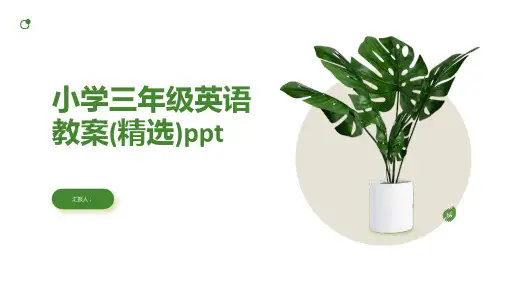


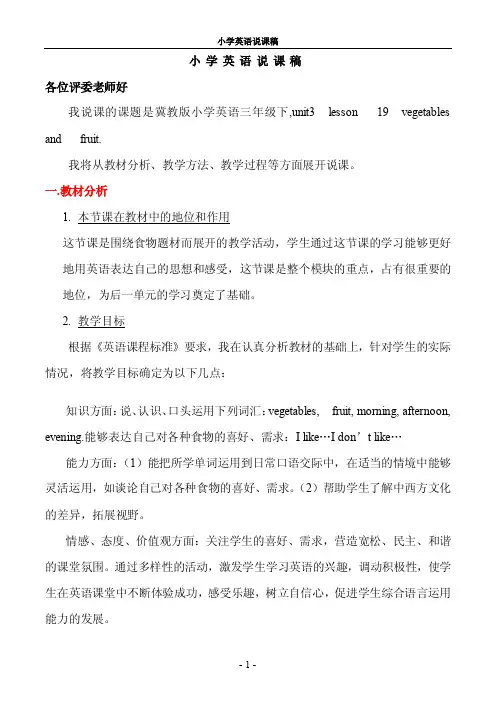
小学英语说课稿各位评委老师好我说课的课题是冀教版小学英语三年级下,unit3 lesson 19 vegetables and fruit.我将从教材分析、教学方法、教学过程等方面展开说课。
一.教材分析1.本节课在教材中的地位和作用这节课是围绕食物题材而展开的教学活动,学生通过这节课的学习能够更好地用英语表达自己的思想和感受,这节课是整个模块的重点,占有很重要的地位,为后一单元的学习奠定了基础。
2.教学目标根据《英语课程标准》要求,我在认真分析教材的基础上,针对学生的实际情况,将教学目标确定为以下几点:知识方面:说、认识、口头运用下列词汇:vegetables, fruit, morning, afternoon, evening.能够表达自己对各种食物的喜好、需求:I like…I don’t like…能力方面:(1)能把所学单词运用到日常口语交际中,在适当的情境中能够灵活运用,如谈论自己对各种食物的喜好、需求。
(2)帮助学生了解中西方文化的差异,拓展视野。
情感、态度、价值观方面:关注学生的喜好、需求,营造宽松、民主、和谐的课堂氛围。
通过多样性的活动,激发学生学习英语的兴趣,调动积极性,使学生在英语课堂中不断体验成功,感受乐趣,树立自信心,促进学生综合语言运用能力的发展。
3.教学重点:说、认识、口头运用vegetables, fruit,表达自己对各种食物的喜好、需求是本课的重点。
4.教学难点:让学生理解新学句型I do in the morning /in theafternoon/ in the evening ,并能在相应的语境中灵活运用。
二.教学方法为了顺利完成教学目标,更好地突出重点,突破难点,我根据小学生好奇、好动的特点,采取了情景假设法、直观演示法、游戏法相结合的教学方法,鼓励学生多开口、多交流,激发学生学习英语的兴趣,提高他们学习英语的积极性。
三.学习方法我在课堂教学中,运用多种方法促使学生多听、多读、多说,通过实践提高学生英语的灵活运用能力,学生在互动、交流的活动中建立起自信,享受到学习的乐趣,进而促使他们形成自主、探究性的学习方法。